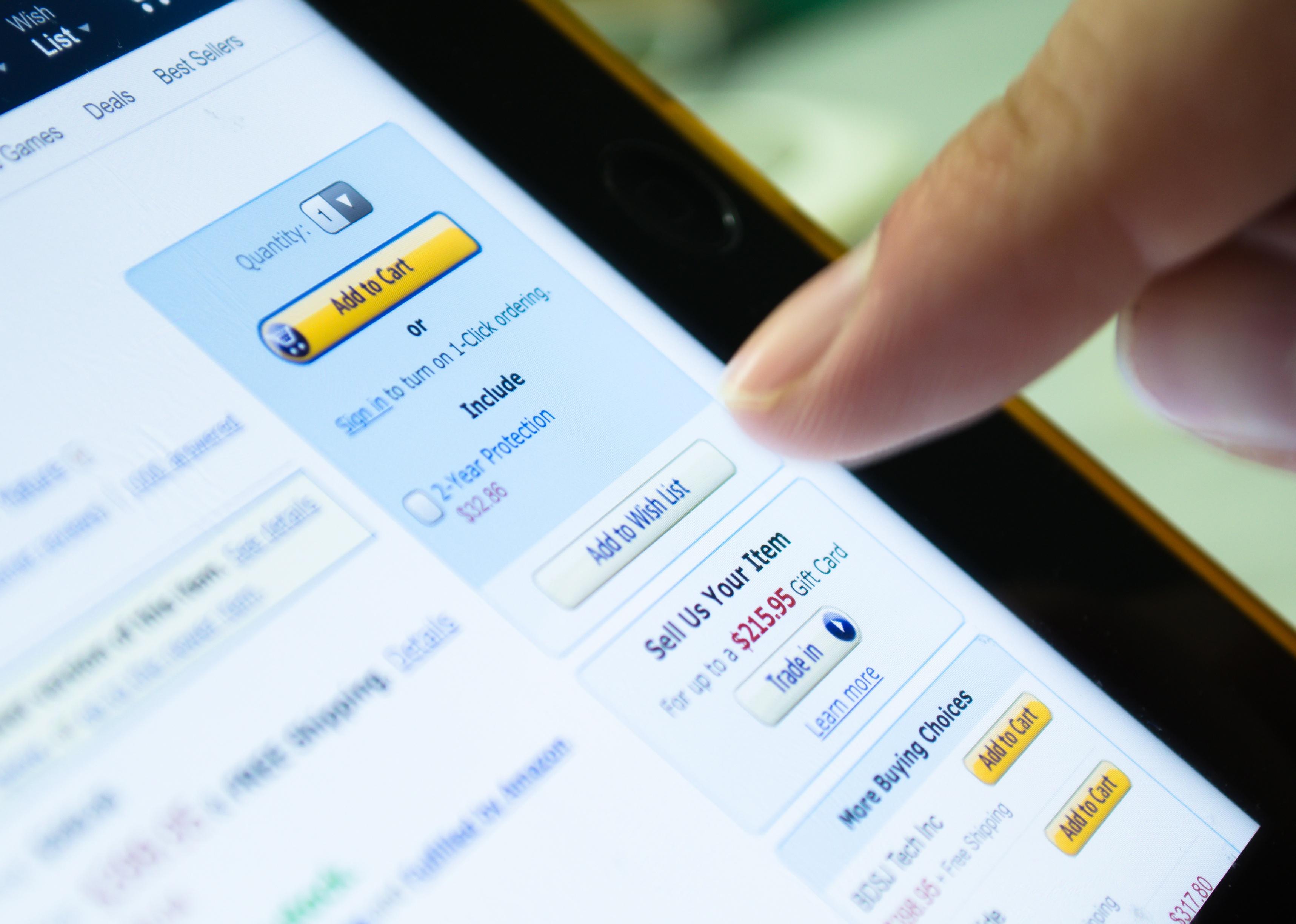How inflation has impacted your Amazon cart
PeoGeo // Shutterstock
How inflation has impacted your Amazon cart
Unidentified finger touches screen of tablet device on ‘Add to Wish List’ button in Amazon.
The perfect Christmas gift for a family member, household items like dog food or laundry detergent for the month, or the next season of your favorite TV show: When you’re on the Amazon platform, nearly everything you need is at your fingertips. But with high inflation, it’s no surprise that Amazon prices are rising, too. But which items’ prices are being most affected by inflation?
Stacker analyzed historical price data from Amazon to determine how inflation affected the platform’s customers’ prices. For 25 items, current and historical data was collected using Keepa, which monitors the price of nearly 1 billion products on Amazon in the U.S. Pricing data was collected for Nov. 18, 2021, and compared to the price of the same item on Nov. 18, 2022.
The basket of goods was created by selecting five household items commonly purchased through Amazon in five categories. Two rules were followed to select specific items in each category: The item’s seller must have been Amazon and not a third party, and there must be price data for at least one year. After those considerations, selected items were, wherever possible, labeled “bestseller.” Generally, items that were marked “sponsored” were not considered unless they were also labeled as bestsellers. When possible, smaller units of sales were used instead of bulk purchases. When only bulk purchases were available, a size was chosen that a household might reasonably consider buying.
While this analysis does give an idea of how inflation has impacted the cost of goods on Amazon, it is not a comprehensive measure of inflation across the entire platform.
The 12-month unadjusted inflation in October 2022 was 7.7%, according to the Bureau of Labor Statistics. Using the basket of goods in this story—which looks at only household goods and excludes many of the items included in the BLS calculation—inflation on Amazon was about 17%.
To learn more about what this inflation looks like when it comes to buying the five most commonly purchased household items on the Amazon platform, keep reading.
You may also like: Iconic car debuts from the year you were born
![]()
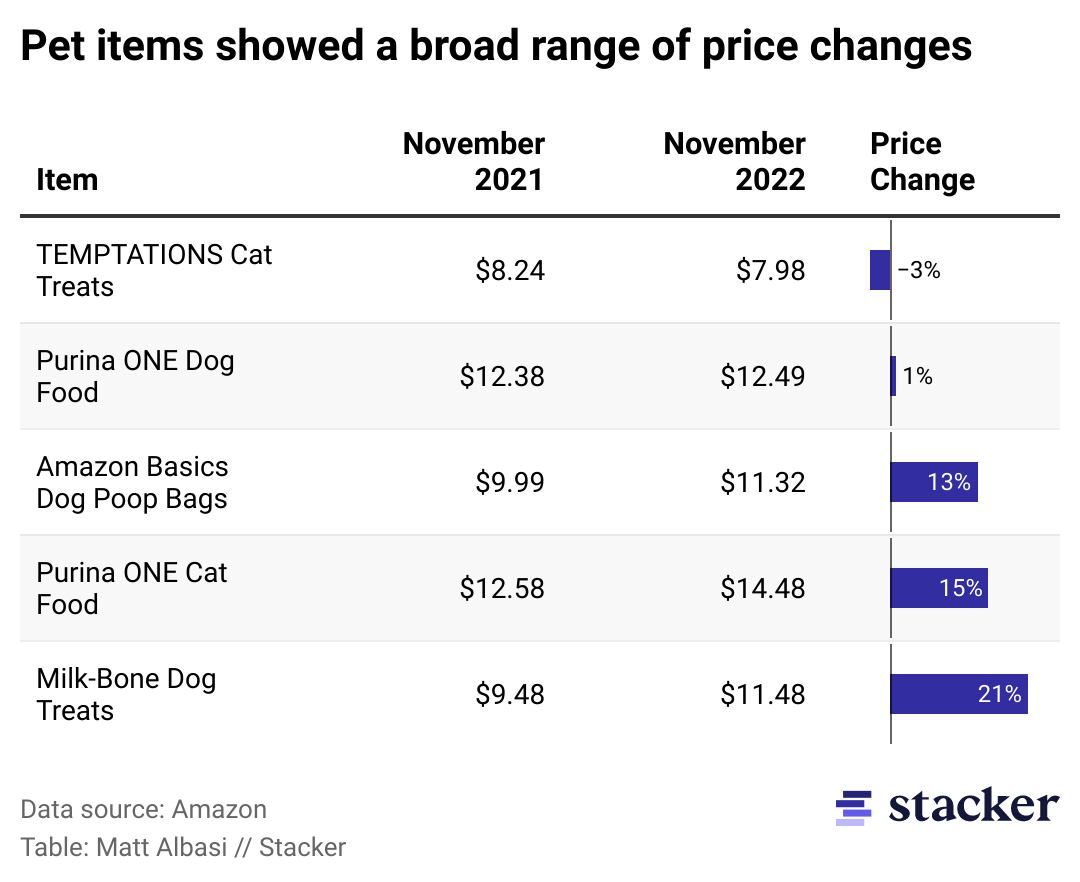
Matt Albasi // Stacker
Pets
A table showing the price changes of pet items.
– Total increase for these five items: 9.6%
Pet owners spend mostly on essentials like food for their pets, according to Target and Walmart, and not buying less important products like toys. Because pet owners are already struggling with inflation and pet care costs, they simply can’t afford to pay for discretionary products—and some pet owners are even finding themselves in the position where they have to give up ownership of their furry friend.
The total increase for the most commonly purchased pet products on Amazon is far less than the increase for health items and just below the increase for toiletries. This may be partly because the cat treats got slightly cheaper.
Pet food, an essential product for pet owners, has gone up significantly in cost, even when compared to the rise in the cost of human food. As of September this year, pet food’s Consumer Price Index had risen by nearly 14% in the past year—while the increase for human food over the same period was 10.9%.
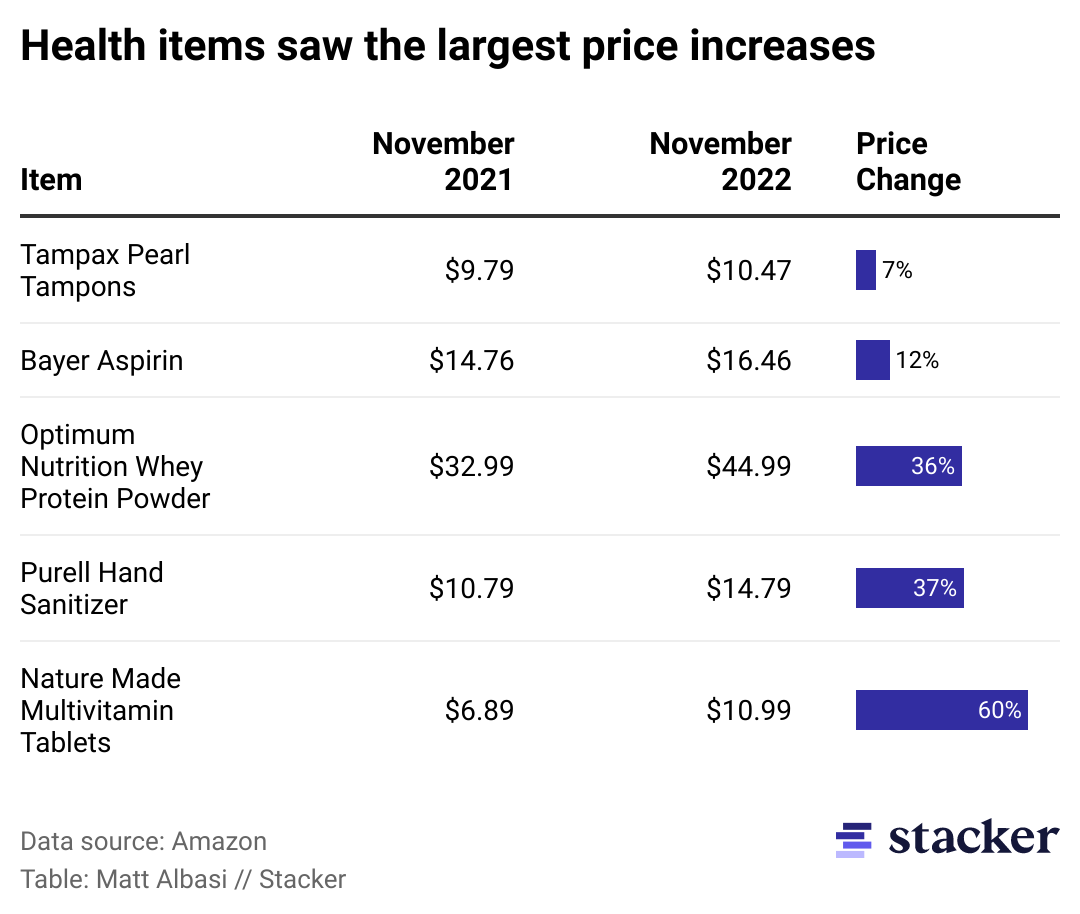
Matt Albasi // Stacker
Toiletries
A table showing the price changes of toiletries.
– Total inflation for these five items: 11.0%
Two in 10 Americans buy personal care items in bulk, seeking to save a bit of money as inflation bites. And 5 in 10 buy paper products in bulk, including toilet paper. Inflation will likely reduce demand for medium-sized packaging, as consumers choose to either buy in bulk or buy less overall, according to GlobalData.
The rising cost of oil has driven up the cost of many consumer products, such as toothpaste. Toiletries prices rose slightly more than pet items’ prices, but half as much as home essentials prices and one-third as much as health items’ prices.
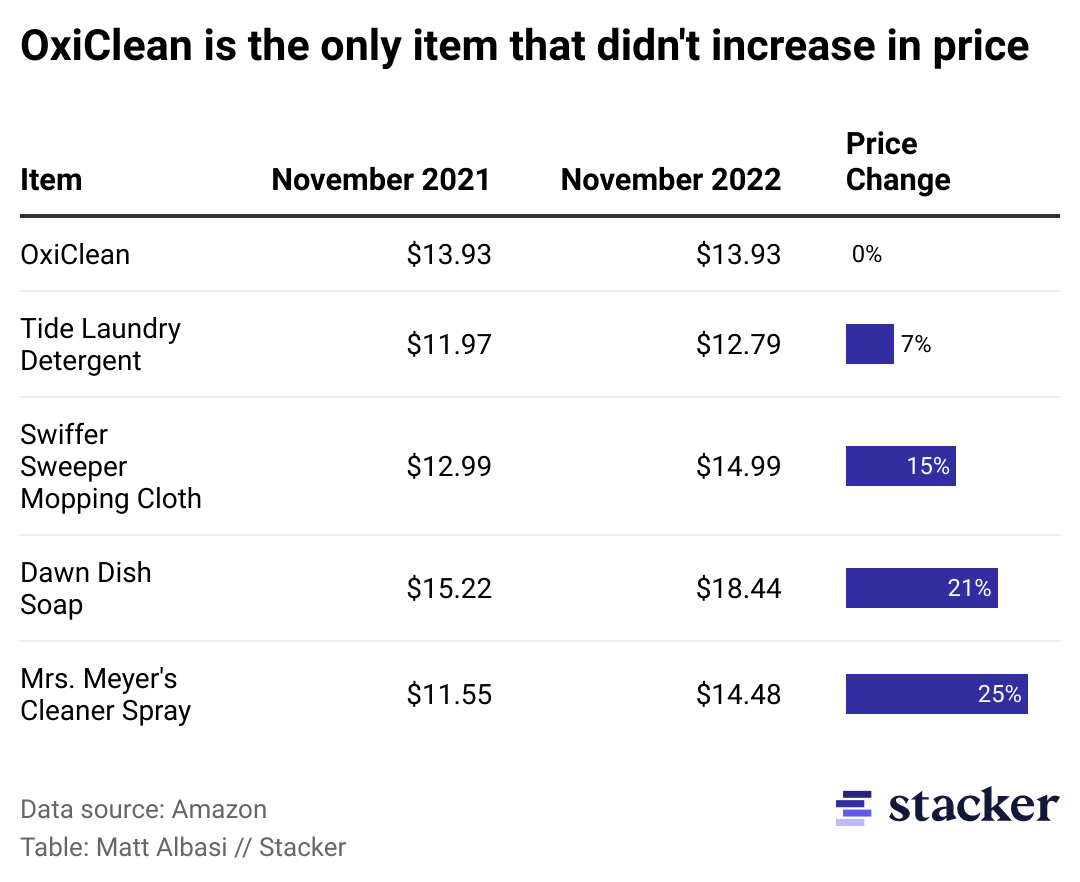
Matt Albasi // Stacker
Household cleaning
A table showing the price changes of household cleaning items.
– Total increase for these five items: 13.7%
Between October 2021 and October 2022, the cost of household cleaning products went up by 11.5%, according to federal data. As with other types of products, Americans are buying household cleaning products in bulk to save money. The increase in the cost of the items in the household cleaning products list is a little more than half as steep as prices in the home essentials list and just slightly higher than toiletries products.
High-end cleaning products are more expensive partly because of their ingredients. Mrs. Meyer’s, for example, has explained that its prices are higher because it uses raw materials that are sustainable, renewable, and derived only from plants.
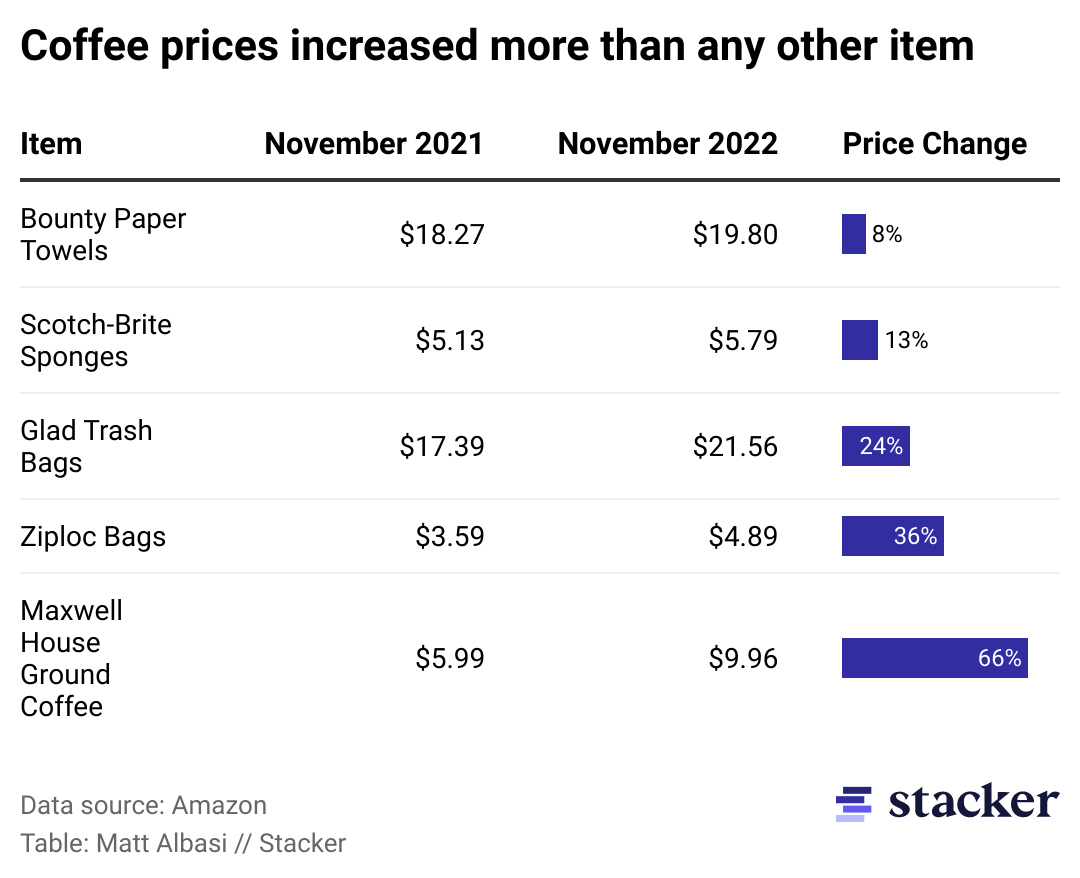
Matt Albasi // Stacker
Home essentials
A table showing the price changes of home essentials.
– Total increase for these five items: 23.1%
The cost of a cup of joe was 7.6% higher, on average, in the first half of 2022 than it had been the year prior. This is in part due to inflation but also because of weather: A cold snap killed off one-third of Brazil’s Arabica coffee bean crop in 2021.
However, there is some good news: In recent weeks, the cost of coffee beans has gone down by 20%, which might mean savings for coffee lovers—if retailers pass their savings on to customers instead of keeping the difference for themselves.
Home essentials prices increased far more than pet, toiletries, and cleaning items, but still less than health-related items.
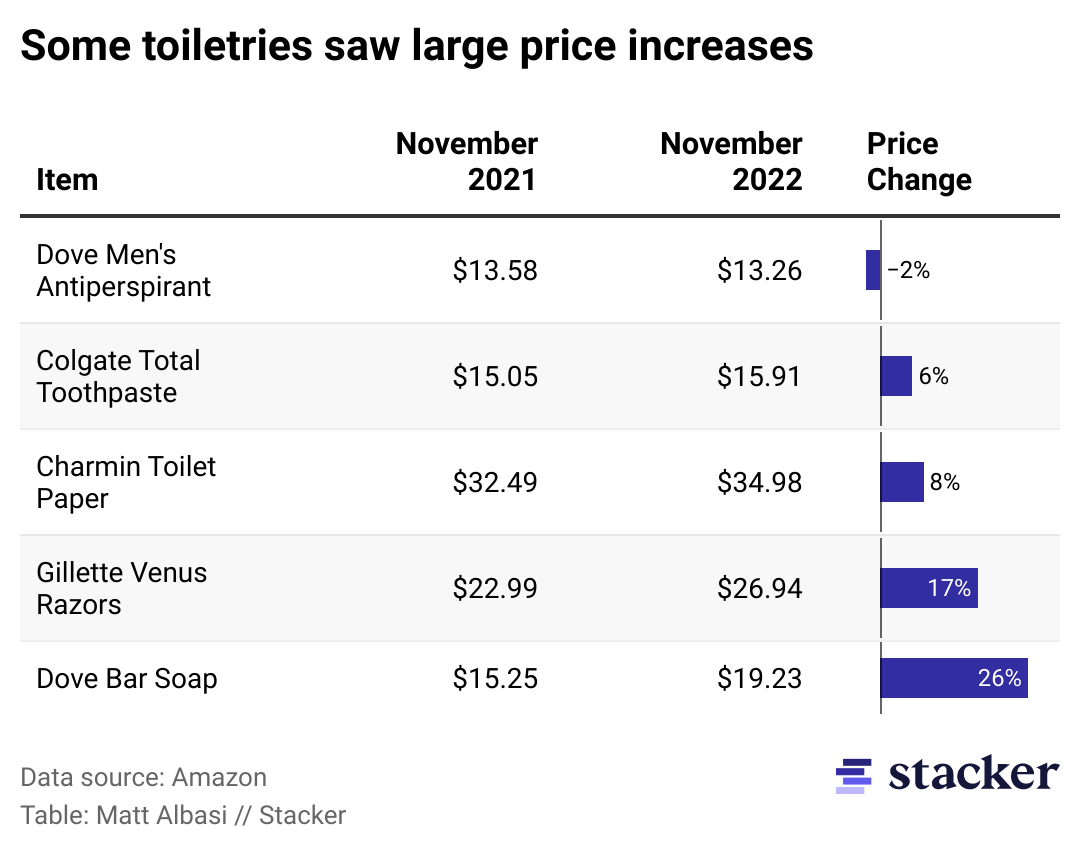
Matt Albasi // Stacker
Health
A table showing the price changes of health items.
– Total inflation for these five items: 29.9%
The 60% increase in the price of Nature Made Multivitamin Tablets is just one example of how inflation has affected the nutrition supply chain. As with other sectors, water shortages, extreme weather, increased labor costs, labor shortages, port congestion, and soaring freight costs also made the cost of supplements and other nutrition industry products even higher.
Hand sanitizer’s price has climbed in part because of crude oil price fluctuation, and the effects of Russia’s invasion of Ukraine—as well as, of course, higher demand in the wake of the COVID-19 pandemic.
Prices for health-related items climbed higher than in any other category in this analysis, more than three times as fast as pet items and well beyond home essentials, the category with the next-highest increase.
Inflation has also made menstrual products more expensive. As of November 2022, the average price per unit for tampons and sanitary pads was more than 10% higher than a year earlier. These price hikes are also compounded by the fact that some states do not exempt menstrual products from sales tax—and do not allow them to be paid for with food stamps or other welfare program benefits.
You may also like: Do you know the brands behind these famous slogans?
